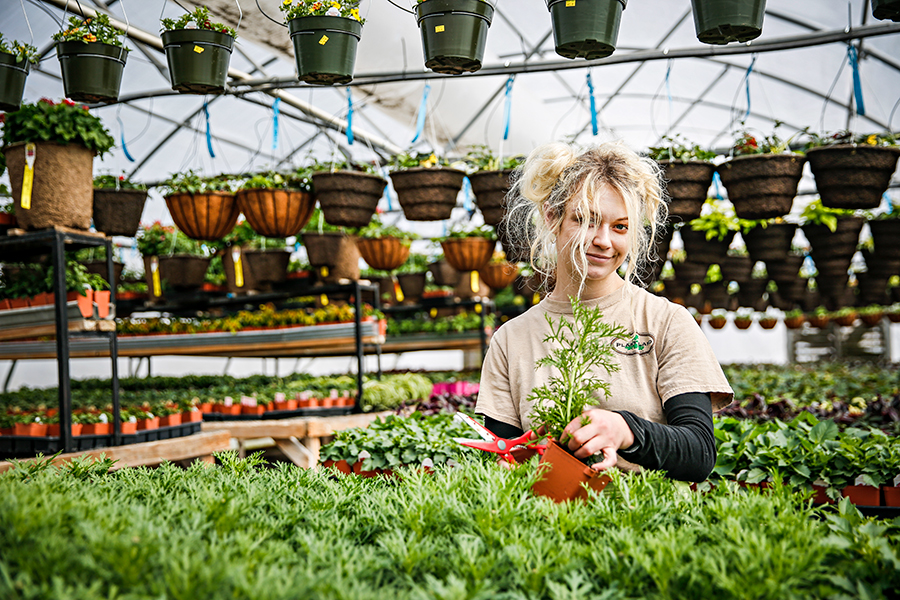Growth in Gardening
Local businesses are experiencing increased seed and vegetable sales as people turn to gardening for therapy, activity and to create their own food supply
By Maggie Dresser
For the first time in 34 years, Plant Land Garden Center Manager Michelle Grigsby recently had to limit the sale of seed potatoes to 10 pounds per family in Kalispell in order to manage the high consumer demand.
“I have had people calling from all over the state of Montana,” she said.
In addition to potatoes, Grigsby is selling out of seeds unusually fast, especially staples like tomatoes, peppers, lettuce and onions. She’s had to reorder seeds six or seven times so far this spring, which she normally does only once or twice by this time.
Heather Estrada, the Agriculture Program Director and Associate Professor at Flathead Valley Community College (FVCC), speculates the uptick in gardening this year is driven by a few factors. She says for a lot of people, it’s likely a therapeutic release. For people stuck at home, it’s a way to connect with nature and have something to do around the house. Gardening is also a great activity for parents to do with their kids while they are homeschooling, she said.
Estrada will also be keeping her eye on the potential impact of grocery-store supply disruptions on gardening.
“I don’t know that supply will actually be an issue,” she said. “But some of the supplies of our fresh produce like strawberries could be disrupted because there’s a lot of restrictions on people crossing borders. I don’t know what the implications will be, but it’s something to think about.”
Dara Palmer, the Montana Master Gardener Coordinator at Montana State University, says there is always a significant increase in course enrollment when the economy is in a downturn, which she also noticed in 2008 during the economic crisis. She’s noticed that World War I and World War II era “Victory Gardens,” which encouraged people to create their own food supply and release pressure on public food supply, are making a comeback.
Estrada says that staples like wheat and rice don’t seem to be at risk for a supply shortage, but certain fresh produce might not be readily available at the consumer’s convenience.
“When you think about the food supply, it’s not only to grow but to distribute and package and transport food around the country,” Estrada said. “There are only so many trucks and workers (right now).”

Estrada said supply chains are a big focus in her “Building Community Food Systems” course at FVCC, and COVID-19 adds a new element. She says the pandemic further emphasizes the importance of strong local food systems.
“We’re really lucky here because we have this really strong community of farmers who are able to meet our community’s demand for fresh produce, which I think is really important to say,” she said.
With the increased interest, Estrada encourages new gardeners to educate themselves through online resources while talking to experienced gardeners and farmers. She says it’s important to know where the compost and topsoil comes from to ensure it doesn’t contain herbicides while making sure wildlife doesn’t invade garden space.
At Plant Land, Grigsby has been posting live Facebook streams of gardening tutorials. With an active Facebook newsfeed, she says every time she posts a new item in stock, customers are in the next day buying that same item.
Kevin Morin, owner of Wild Geese Gardens, is noticing a similar uptick in gardening interest at his store in Kalispell, too. He’s ordering twice as many seeds as he would normally, and like Grigsby, he’s also selling a lot of vegetable seeds.
But after growing one of his best crops of flowers this year, he’s worried nobody will buy them because people have fewer dollars to spend and are only focused on vegetables right now. But Morin is shifting his focus primarily to vegetables and preparing for a wave of sales once planting season starts.
Estrada sees the increased gardening interest as a positive side effect of the COVID-19 pandemic, and she hopes this creates awareness surrounding healthy food systems and new hobbies. She hopes people will have a new understanding about where food comes from, and she sees this as an even better reason to support local farmers.
“And growing a garden is fun, relaxing, therapeutic and educational,” she said.